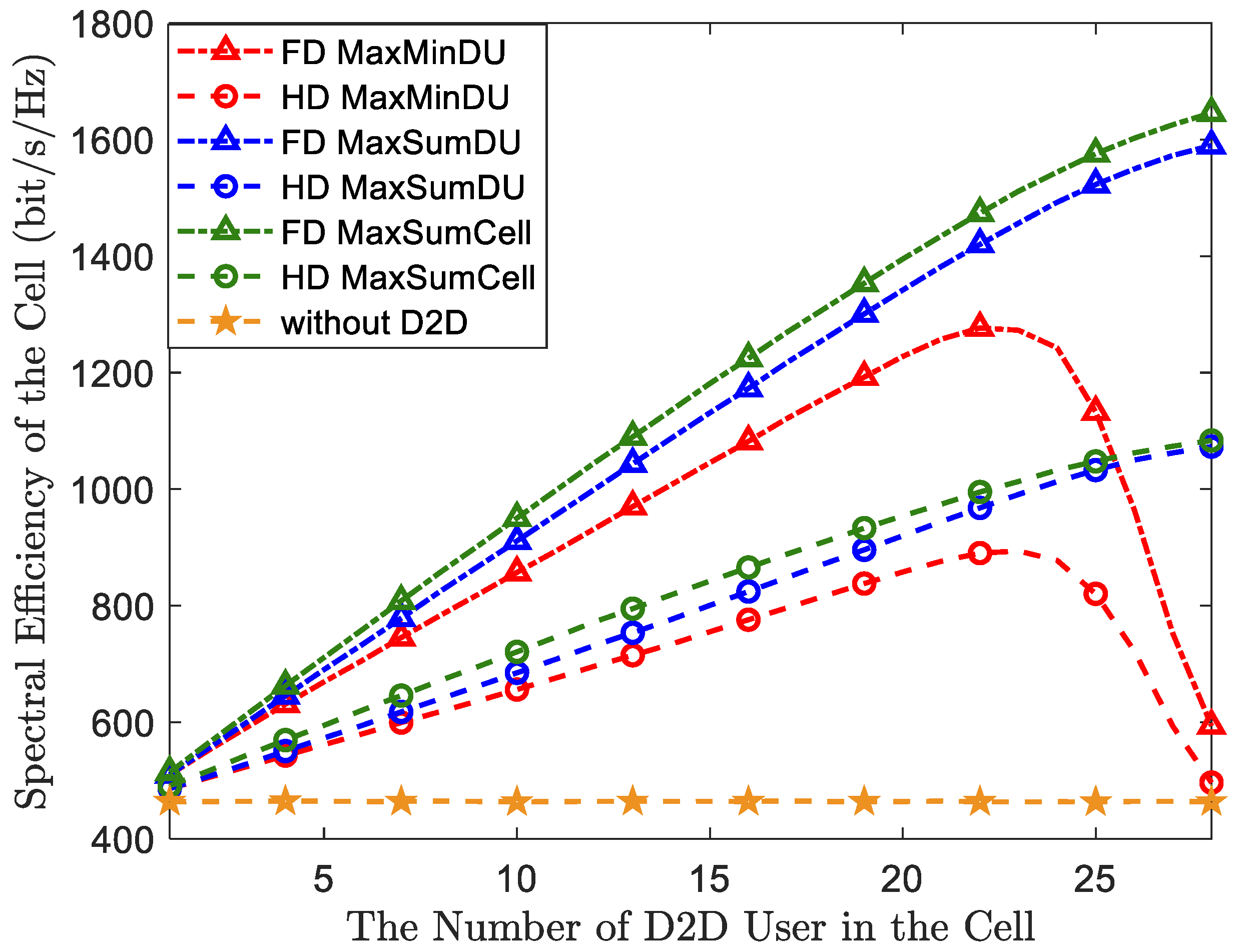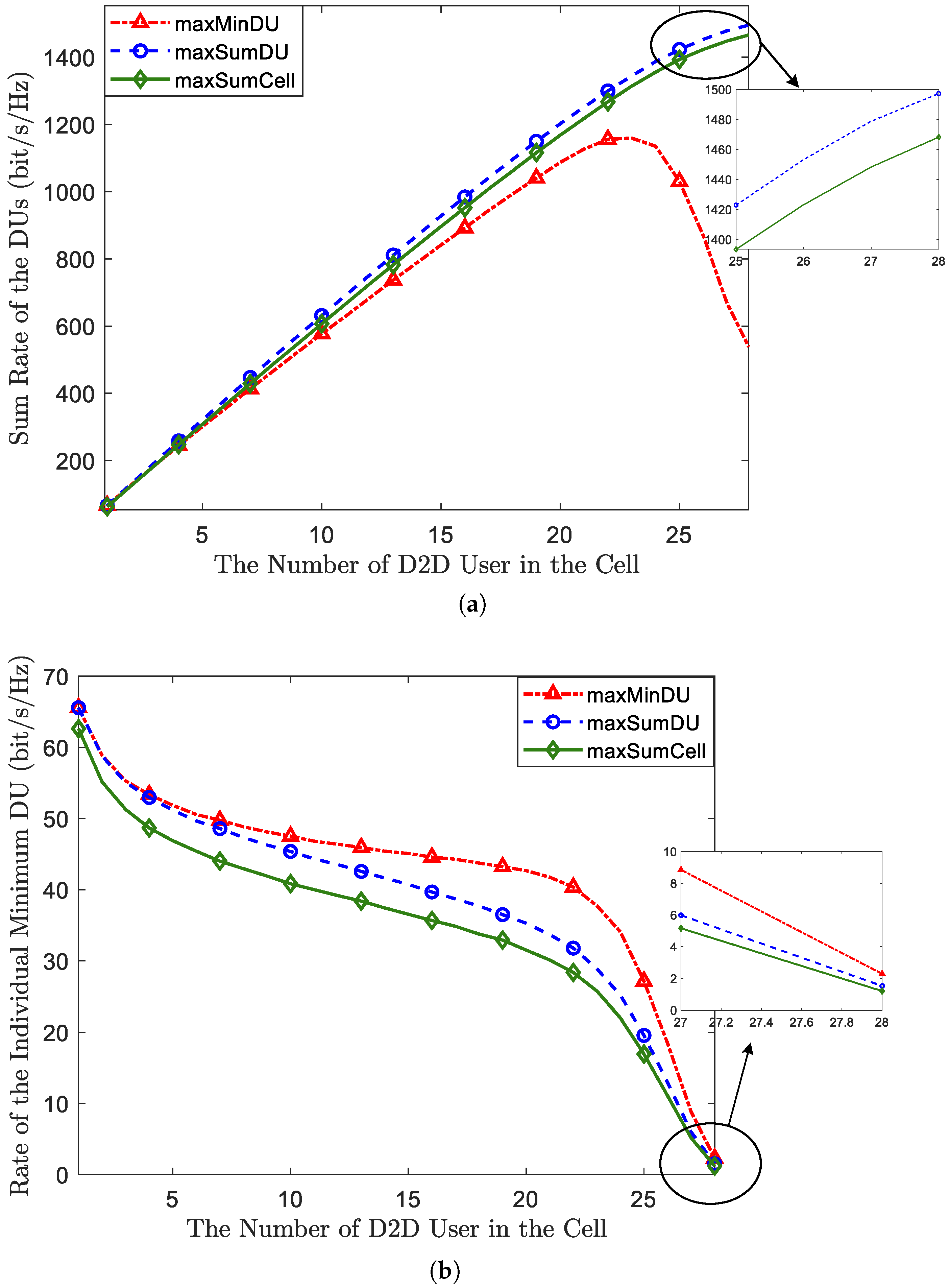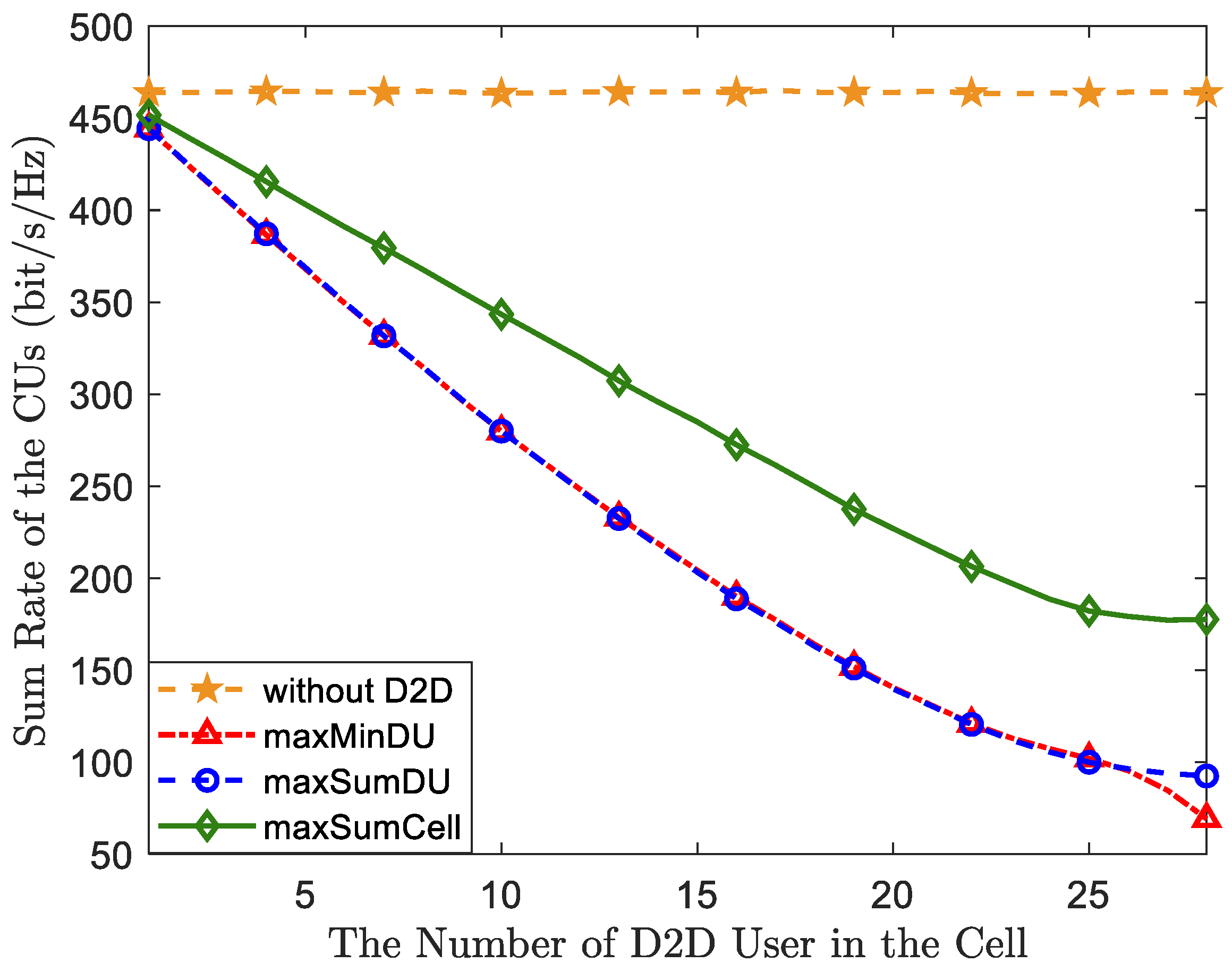Joint Power Control and Resource Allocation for Optimizing the D2D User Performance of Full-Duplex D2D Underlying Cellular Networks
Abstract
:1. Introduction
- For the first algorithm, our objective is to maximize the sum rate of DUs in an FD-D2D underlying system to enhance the performance of FD-DUs. This optimization problem is formulated as a MINLP problem, which is then decomposed into two subproblems: power control and resource allocation. In the first subproblem, we determine the optimal power allocation that maximizes the rate of each DU in the spectrum sharing of each CU-DU pair. This is achieved through a one-dimensional search within a finite set of power levels. Next, in the second subproblem of resource allocation, we employ the Kuhn–Munkres maximal weight method to identify the optimal pairing of each DU with a CU for the purpose of maximizing the sum rate of all DUs within the cell. The first algorithm is referred to as MaxSumDU-OP (maximizing sum rate of dus with optimal power and optimal pairing) in the following sections of this paper.
- The MaxSumDU-OP algorithm focuses on maximizing the overall sum rate for DUs, but it does not guarantee uniform user performance for each individual D2D pair. In order to address this limitation, we introduce the second algorithm, which aims to maximize the minimum rate among all D2D pairs. This approach ensures a more uniform user performance experience across all DUs. What sets the second algorithm apart from MaxSumDU-OP is its approach to solving the resource allocation subproblem. We have developed a uniform performance algorithm for this purpose, which utilizes bisection searching and multiple iterations of the Kuhn–Munkres method. This approach helps identify optimal sharing pairings to guarantee individual user experiences for D2D pairs. We denote this second algorithm as MaxMinDU-OP (maximizing the minimum rate of D2D user pairs with optimal power and optimal pairing).
- The two proposed algorithms jointly share uplink and downlink spectrum resources, aiming to achieve higher system capacity gains while ensuring the performance of D2D links.
2. System Model
3. FD-DUs Capacity Maximization Design
3.1. Problem Formulation
3.2. Power Control
3.3. Resource Allocation
| Algorithm 1 The optimal resource allocation algorithm for the sum FD-DUs maximization design |
|
4. Individual FD-DU Capacity Uniform Design
4.1. Problem Formulation
4.2. Resource Allocation
| Algorithm 2 Part 1 of the optimal resource allocation algorithm for |
|
| Algorithm 3 Part 2 of the optimal resource allocation algorithm for |
|
5. Numerical Results Analysis
6. Conclusions
Author Contributions
Funding
Institutional Review Board Statement
Informed Consent Statement
Data Availability Statement
Conflicts of Interest
References
- Islam, T.; Kwon, C. Survey on the state-of-the-art in device-to-device communication: A resource allocation perspective. Ad Hoc Netw. 2022, 136, 102978. [Google Scholar] [CrossRef]
- Feng, D.; Lu, L.; Wu, Y.Y.; Li, G.Y.; Feng, G.; Li, S. Device-to-Device Communications Underlaying Cellular Networks. IEEE Trans. Commun. 2013, 61, 3541–3551. [Google Scholar] [CrossRef]
- Zhang, H.; Song, L.; Han, Z. Radio resource allocation for device-todevice underlay communication using hypergraph theory. IEEE Trans. Wirel. Commun. 2016, 15, 4852–4861. [Google Scholar]
- Ni, M.; Pan, J. Throughput Analysis for Downlink Resource Reusing D2D Communications in Cellular Networks. In Proceedings of the IEEE Global Communications Conference (GLOBECOM), Singapore, 4–8 December 2017; pp. 1–7. [Google Scholar]
- Kai, C.; Xu, L.; Zhang, J.; Peng, M. Joint Uplink and Downlink Resource Allocation for D2D Communication Underlying Cellular Networks. In Proceedings of the 2018 10th International Conference on Wireless Communications and Signal Processing (WCSP), Hangzhou, China, 18–20 October 2018; pp. 1–6. [Google Scholar]
- Lee, N.; Lin, X.; Andrews, J.G.; Heath, R.W., Jr. Power control for D2D underlaid cellular networks: Modeling, algorithms, and analysis. IEEE J. Sel. Areas Commun. 2015, 33, 1–13. [Google Scholar] [CrossRef]
- Kai, C.; Wu, Y.; Peng, M.; Huang, W. Joint Uplink and Downlink Resource Allocation for NOMA-Enabled D2D Communications. IEEE Wirel. Commun. Lett. 2021, 10, 1247–1251. [Google Scholar] [CrossRef]
- Kai, C.; Li, H.; Xu, L.; Li, Y.; Jiang, T. Joint Subcarrier Assignment with Power Allocation for Sum Rate Maximization of D2D Communications in Wireless Cellular Networks. IEEE Trans. Veh. Technol. 2019, 68, 4748–4759. [Google Scholar] [CrossRef]
- Wang, H.; Ding, G.; Wang, J.; Wang, L.; Tsiftsis, T.A.; Sharma, P.K. Resource allocation for energy harvesting-powered D2D communications underlaying cellular networks. In Proceedings of the 2017 IEEE International Conference on Communications (ICC), Paris, France, 21–25 May 2017; pp. 1–6. [Google Scholar]
- Nguyen, H.H.; Hasegawa, M.; Hwang, W.J. Distributed resource allocation for D2D communications underlay cellular networks. IEEE Commun. Lett. 2016, 20, 942–945. [Google Scholar] [CrossRef]
- Shi, C.; Pan, W.; Shao, S. RF Wideband Self-Interference Cancellation for Full Duplex Phased Array Communication Systems. In Proceedings of the ICC 2022—IEEE International Conference on Communications, Seoul, Republic of Korea, 16–20 May 2022; pp. 1094–1099. [Google Scholar]
- Shi, C.; Pan, W.; Shen, Y.; Shao, S. Robust Transmit Beamforming for Self-Interference Cancellation in STAR Phased Array Systems. IEEE Signal Process. Lett. 2022, 29, 2622–2626. [Google Scholar] [CrossRef]
- He, Y.; Zhao, H.; Guo, W.; Shao, S.; Tang, Y. Frequency-Domain Successive Cancellation of Nonlinear Self-Interference with Reduced Complexity for Full-Duplex Radios. IEEE Trans. Commun. 2022, 70, 2678–2690. [Google Scholar] [CrossRef]
- Yang, T.; Zhang, R.; Cheng, X.; Yang, L. Graph Coloring Based Resource Sharing (GCRS) Scheme for D2D Communications Underlaying Full-Duplex Cellular Networks. IEEE Trans. Veh. Technol. 2017, 66, 7506–7517. [Google Scholar] [CrossRef]
- Hemachandra, K.T.; Rajatheva, N.; Latva-Aho, M. Sum-rate analysis for full-duplex underlay device-to-device networks. In Proceedings of the 2014 IEEE Wireless Communications and Networking Conference (WCNC), Istanbul, Turkey, 6–9 April 2014; pp. 514–519. [Google Scholar]
- Cheng, W.; Zhang, X.; Zhang, H. Optimal power allocation for full-duplex D2D communications over wireless cellular networks. In Proceedings of the 2014 IEEE Global Communications Conference, Austin, TX, USA, 8–12 December 2014; pp. 4764–4769. [Google Scholar]
- Li, S.; Ni, Q.; Sun, Y.; Min, G. Resource allocation for weighted sumrate maximization in multi-user full-duplex device-to-device communications: Approaches for perfect and statistical CSIs. IEEE Access 2017, 5, 27229–27241. [Google Scholar] [CrossRef]
- Liu, F.; Hou, X.; Liu, Y. Capacity improvement for full duplex deviceto-device communications underlaying cellular networks. IEEE Access 2018, 6, 68373–68383. [Google Scholar] [CrossRef]
- Vu, H.V.; Tran, N.H.; Le-Ngoc, T. Full-Duplex Device-to-Device Cellular Networks: Power Control and Performance Analysis. IEEE Trans. Veh. Technol. 2019, 68, 3952–3966. [Google Scholar] [CrossRef]
- Chung, M.; Sim, M.S.; Kim, D.K.; Chae, C. Compact full-duplex MIMO radios in D2D underlaid cellular networks: From system design to prototype results. IEEE Access 2017, 5, 16601–16617. [Google Scholar] [CrossRef]
- Khandaker, M.R.A.; Masouros, C.; Wong, K. Secure full-duplex device-to-device communication. In Proceedings of the 2017 IEEE Globecom Workshops (GC Wkshps), Singapore, 4–8 December 2017; pp. 1–6. [Google Scholar]
- Bjornson, E.; Jorswieck, E.A.; Debbah, M.; Ottersten, B. Multiobjective signal processing optimization: The way to balance conflicting metrics in 5G systems. IEEE Signal Process. Mag. 2014, 31, 14–23. [Google Scholar] [CrossRef]
- Liang, L.; Li, G.Y.; Xu, W. Resource Allocation for D2D-Enabled Vehicular Communications. IEEE Trans. Commun. 2017, 65, 3186–3197. [Google Scholar] [CrossRef]






| Notation | Definition |
|---|---|
| the gain of fast fading with an exponential distribution | |
| the gain of slow fading with a log-normal distribution | |
| G | the path loss constant |
| the path loss exponent | |
| the distance between CUj and the BS |
| Parameter | Value |
|---|---|
| Cell radius | 500 m |
| Fast fading | mean = 1 |
| Slow fading | standard deviation = 8 dB |
| Pathloss exponent () | 3 |
| Pathloss constant (G) | |
| Noise spectral density () | dBm/Hz |
| Users distribution | Uniform |
| , | 24 dBm |
| 46 dBm | |
| Number of CUs (T) | 28 (50% uplink & 50% downlink) |
| Number of DUs (S) | 0 to 28 |
| Self-interference cancellation | 110 dB |
| Bandwidth | 10 MHz |
| Number of subcarriers (K) | 20 |
| D2D distance (d) | 8 m |
| ,, | 10 dB |
Disclaimer/Publisher’s Note: The statements, opinions and data contained in all publications are solely those of the individual author(s) and contributor(s) and not of MDPI and/or the editor(s). MDPI and/or the editor(s) disclaim responsibility for any injury to people or property resulting from any ideas, methods, instructions or products referred to in the content. |
© 2023 by the authors. Licensee MDPI, Basel, Switzerland. This article is an open access article distributed under the terms and conditions of the Creative Commons Attribution (CC BY) license (https://creativecommons.org/licenses/by/4.0/).
Share and Cite
Zhou, Y.; Cai, B.; Ding, X. Joint Power Control and Resource Allocation for Optimizing the D2D User Performance of Full-Duplex D2D Underlying Cellular Networks. Sensors 2023, 23, 9549. https://doi.org/10.3390/s23239549
Zhou Y, Cai B, Ding X. Joint Power Control and Resource Allocation for Optimizing the D2D User Performance of Full-Duplex D2D Underlying Cellular Networks. Sensors. 2023; 23(23):9549. https://doi.org/10.3390/s23239549
Chicago/Turabian StyleZhou, Yuetian, Bowen Cai, and Xue Ding. 2023. "Joint Power Control and Resource Allocation for Optimizing the D2D User Performance of Full-Duplex D2D Underlying Cellular Networks" Sensors 23, no. 23: 9549. https://doi.org/10.3390/s23239549
APA StyleZhou, Y., Cai, B., & Ding, X. (2023). Joint Power Control and Resource Allocation for Optimizing the D2D User Performance of Full-Duplex D2D Underlying Cellular Networks. Sensors, 23(23), 9549. https://doi.org/10.3390/s23239549






